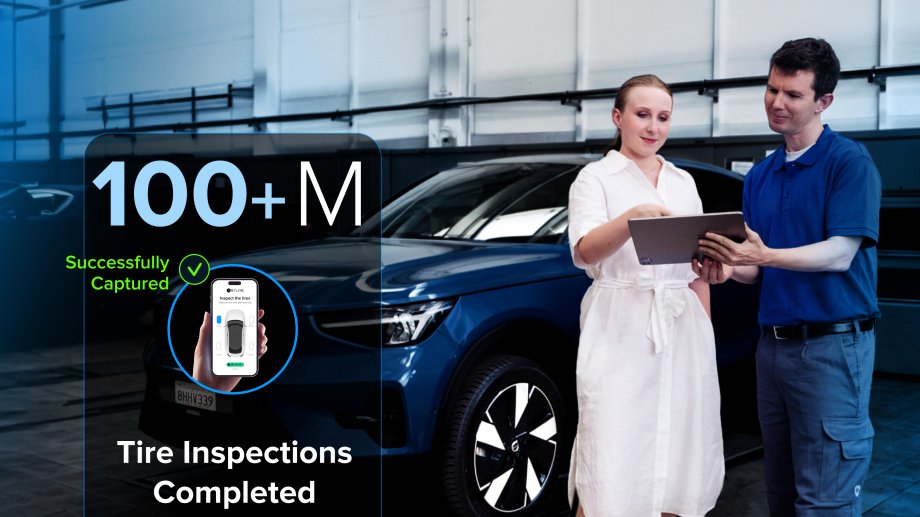
How mobile data capture can improve tyre hotel management
In many European countries winter tyres are mandatory during a legally set period of time. Car owners need to change tyres twice a year, to switch from summer tyres to winter tyres and the other way around once the weather gets warmer.
This means that every car in circulation in these countries needs to have a set of tyres in storage for a significant part of the year. For car owners living outside of urban areas, storing tyres in a private garage may seem like a viable option. However, the conditions might not be optimal for tyre storage, and their performance might deteriorate early.
Thankfully, many tyre service providers offer tyre storage in tyre hotels. At these facilities, car owners can store their tyres for part of the year in a controlled environment for a limited price.
But while this can be very useful for car owners, tyre hotels can be challenging for tyre service providers to operate. Some companies may have tens of thousands of tyres being stored in one warehouse at a time. It’s therefore crucial that staff can quickly and accurately locate and identify each tyre in storage.
Jump to key topics
Jump to key topics

1. The importance of tyre identification for tyre hotels
Tyre hotels sometimes manage tens of thousands of tyres or wheels in a single warehouse, if not more. That’s a lot of tyres that, at first glance look exactly the same when stored on a wheel rack. And when customers come back after 6 months to pick up their summer tyres, they expect to pick them up without any unnecessary delays.
Losing a tyre or confusing one for another can be a major setback for tyre hotel businesses: not only will they have to pay back customers for the price of the lost tyres, but customer satisfaction can also take a serious hit. Who would trust a service provider that lost the item they agreed – and were paid – to take care of?
It’s therefore vital for tyre hotels to clearly identify each tyre that comes in. Usually, a sticker is printed and stuck on the tread facing outward so it’s easy to read, and a barcode can then be scanned to verify which tyre belongs to whom.
2. What kind of data tyre hotels can use for identification
Tyres and cars have the advantage of presenting many types of information that can be used for identification and verification:
- Tyres each have a DOT code and a tyre size code molded on one of their sides. These codes are not unique to a particular tyre, but if recorded when a tyre comes in, it can be verified when customers ask for their tyres back to see if they are matching.
- Tyre sizes codes can also be captured as additional identification data. Comparing dimensions, tire load index and speed symbol to see if they are matching with the recorded information ensures a perfect traceability of each tyre.
- All automobiles have a unique Vehicle Identification Number (VIN), as well as a unique license plate number that can be recorded to identify customers’ vehicles.
- In addition to that, a tyre hotel could record IDs, for example a national ID card, a driver’s license or a passport to identify customers more precisely.
Put together, this data can help identify tyres better, help verify if tyres are matching (stickers could have been misplaced), and if the person getting the tyres back is the person that gave them to be stored 6 months before.
3. The benefits of mobile data capture for tyre identification
There are two main challenges for service providers that offer tyre hotels when it comes to gathering the information required to identify each tyre properly:
- It’s very time-consuming for an employee to write down or type every code or number, whether it’s the DOT code, tyre size, the license plate number or an ID.
- Recording this data manually is an open gate for mistakes. Even the most focused and qualified person will make mistakes at some point, and the longer the codes are, the more chances there are for it to happen.
If a tyre or a customer is not recorded correctly, it can lead to mismatches or losses of tyres.
Hopefully, there is an answer to this problem: mobile data capture.
- With data capture, it becomes possible to collect every piece of information displayed on tyre sidewalls within seconds.
- There’s no chance of errors that way, and you’ll have a better sense of security when you know you aren’t being faced with recording and transcription concerns caused by manual input.
The automation of data collection with a mobile data capture saves tyre hotels valuable time, but also prevents mismatches or tyres getting lost due to erroneous recordings.
4. Why mobile data capture improves customer’s loyalty
Until now, we mainly discussed why tyre hotels need to identify tyre, and how data can help them with that. But the availability of data also means that tyre service providers can work with more information at hand, and better match their customers’ expectations.
Getting ahead of the problem
When a customer comes into a tyre hotel to store its wheels, different types of data is collected in order to identify tyres and to be able to track them in the warehouse when time comes to return them. But what if that information could become more for tyre service providers?
Scanning and recording DOT codes, the tyre size and checking each tyre’s tread depth gives invaluable data to tyre service providers:
- Even though there is no regulation limiting the age of tyres on the road, the industry usually recommends customers to change their tyres after 5 years – according to the German BRV recommandations. The DOT code includes the production date of each tyre, thus its age.
- The minimum depth of a tyre tread is usually 1mm (but that can be much more, especially for winter tyres!). If the tread is shallower than that, it is not suited for the road anymore and needs to be replaced.
Building tailor-made offers with tyre size scanning
By having data such as the age and wear of a tyre, a service provider will know if a customer needs replacement now or in the near future. It allows them to be proactive and engage with customers that have an actual need for new tyres or additional service, whether they are aware of it or not.
Scanning and recording the tyre size is a big advantage for tyre service providers and retailers. It gives them the ability to find a perfect replacement within their stock of the concerned tyres. They can look for tyres with the same size and dimensions, workload index and speed to perfectly fit their customers’ vehicles. It is then possible to offer different tyre models with the right specifications, from various brands and price ranges, from which customers can pick and choose.
5. Integrating every tool in a single mobile device
Integrating mobile data capture into a single device is easy to do with Anyline’s SDK. You can use a number of operating systems, including iOS and Android, along with Xamarin, React-Native, UWP, and Cordova. You can integrate every data capture solution that your business needs, including the ability to scan DOT codes, tyre size codes, VIN, license plates, IDs as well as barcodes.
Anyline’s OCR technology can be used with any device that is camera-enabled, including TPMS tools. It can be used in bad weather, poor lighting, and without an internet connection, so on-site inspections are easier.
A single-vendor solution is the right choice for a trusted tyre hotel management. Download the demo, request a 30-day free trial, or reach out to Anyline today, to find the solution that works for you.

